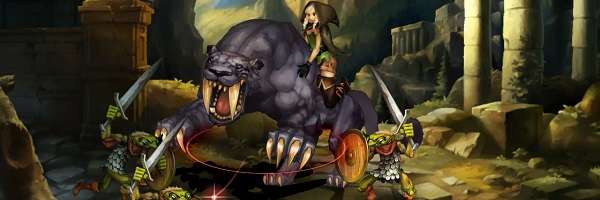
Dragon’s Crown PS3 Review
Great arcade-style beat ‘em ups are few and far between. In this day and age the genre is often short of its true potential. It’s no wonder we get ports of old games with online multiplayer slotted in, because it’s not just nostalgia as a reason we love them, but because they have aged well and are still a blast to play. Just look at Streets of Rage 2 – it’s 20 years old, yet still holds up remarkably well. There have been a few good hitters, such as Castle Crashers, but that is a minority. This is where publisher, Atlus, and developer, Vanillaware, have teamed together to bring one of the most exciting, deep, and mechanically rewarding arcade-style beat ‘em ups in a very long time. Dragon’s Crown is the game that Sacred Citadel wanted to be, and, as a huge fan of the genre, I’m so happy to see it arrive in English.
Taking place in a wonderfully crafted fantasy world, players pick one of the six adventurers (each one representing a class) and must brawl their way through dungeons filled with enemies and loot. The overall story follows the adventurers seeking out the legendary treasure known as the Dragon’s Crown, while getting crossed up in politics between the prime minster and the count, women that have gone missing, a dragon, and a dead wizard who needs help coming back to life. The story isn’t anything to be taken seriously, but it doesn’t matter, since at the end of the day, all the story is doing is making up a situation that requires the player to go somewhere and do something a bit more interesting than simply given a one-line quest of “go here and kill monster.”
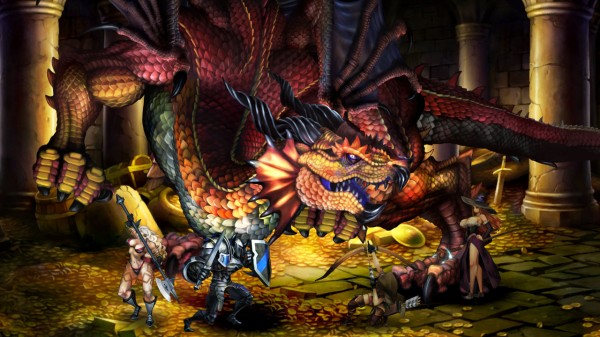
The story is told by one fantastic narrator. He’s got a great voice and delivers lines in such a manner that you’ll enjoy everything he has to say. The narrator also acts as a guide, reading to the player what to do next. You’ll never get lost with such a calm and collected narrator to guide you. Even though it’s just a voice, he’s the guy with the most character in the game, which can’t be said for the selectable heroes, as there is zero character development for any of the featured cast. They are essentially avatars with unique move sets, but that’s all they need to be. Again, it’s not needed in a game like Dragon’s Crown, a game that gets the important parts right when it comes to crafting a great beat ‘em up.
While the playable characters don’t have much in ways of personality, each one is unique when it comes to how they play. Not one of them feels like a clone or a palette swap of an existing class. There’s so much depth to each of the six classes that playing through the game multiple times with the different classes is worth it. I made my way through the game with three classes to experience the recommendation system that the game explains to the user when picking a character.
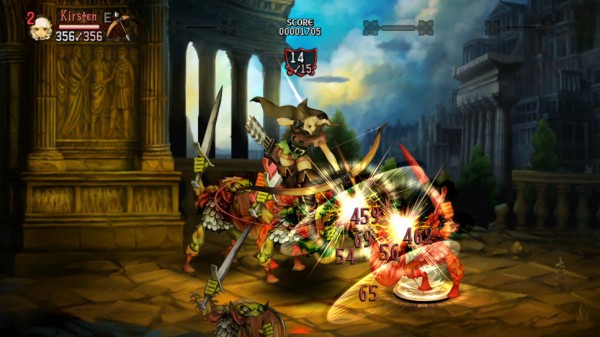
I first went with the Fighter, a class that the game mentions that anyone can play with. He’s covered in plate armour and has a sword and shield, allowing him to block and attack swiftly with short swipes of his sword. The Amazon is another melee based character, but is more agile than the Fighter, since she can dash around and deal high damage with her two-handed weaponry, but suffers from low defence. To make up for this, she can parry attacks or go into berserk mode by swapping life for power to deal even more destruction. The last character I played with was the curvaceous sorceress, which is a class for advanced players. The reason for this is because her melee is very weak. Instead, she relies on her magic (assigned to circle button) to do most of her damage. Magic isn’t unlimited, as the player must recharge when she runs out of juice by holding down the square button. This happens often, so players must be mindful of her MP. The sorceress is a supportive role, relying on her skills to summon skeletons or conjure debuffs on the enemy.
Getting combat correct in a brawler is one thing that needs to be done right. Make it too thin and it can get boring, but make it too complex and you risk pushing away the lesser hardcore crowd. Thankfully, Dragon’s Crown gets it just right. There is plenty of depth here, but it’s not forced on the player (the class difficulty helps). If you just want to hammer at enemies, then you are free to do so; if you want to go further, then you can begin to extend damage and use the advanced mechanics, such as extending combos with air dashing, juggling, move cancelling and even getting your cooperative friends to join in the punishment by directing the movement of enemies when you hit them into your buddy’s line of fire. When there are four heroes on screen and the enemies are raining in, the combat becomes exceptionally chaotic, but it’s a fascinating kind of chaotic that makes it very entertaining.

What helps on top of the great combat is the diversity in level and boss design. Every stage has its own twist that requires players to do something different. One level has you riding a magic carpet across a steaming river of lava, as a magma wave hurls behind you, throwing pieces of hot lava at your magic carpet. If the carpet gets burnt, then it causes the party to crash early, which translates into missing an S rank piece of loot. Another good example is in the catacombs, where you need to fend off female spirits with fire. This can be done by using the torches that can be picked up off the walls or having a supporting sorceress attack with fire magic. This is a beat ‘em up that does more than rely on going straight.
Bosses are intelligently designed, often offering two ways to finish them. Killing them grants bonus loot and gold, but the game puts you on an unknown time limit. If you take too long defeating a boss, then some outside force will interrupt you. Defeating such adversaries isn’t as simple as always relying on mashing attack to win. One such fight against a vampire requires the adventurers to defend captured females against the vampire’s bite, while another fight with the Wraith requires the party to activate the goddess light, which is a light source that emits from a statue. Whenever this is on, the Wraith reveals its weak point (the heart) and you can beat on it until the light dies down. Rinse and repeat to win, unless you run out of statues, then you end up into a special chamber full of light. The Wraith cannot follow here, so players are left with a sour tasting end to the dungeon, since far fewer rewards are given for going the “easy” way out of the fight. The extra mile the developers have put in to make each location distinct is what makes Dragon’s Crown stand out.

An RPG level system is built into the game to give characters progression and customisation. As you probably expect, simply completing a dungeon and defeating foes gives you experience to level up. Also, accepting quests from the Adventurers Guild and successfully accomplishing them will also offer experience. Side quests can range from easy challenges, such as defeating ten owlbears, to more mysterious tasks, like having to find a secret doll behind a crumbling wall. The Adventurers Guild is the place to go if you want to buy new skills for your hero. In here, you can spend the skills points earned from levelling up on class specific or common skills. This helps build the class how you want to use them. I didn’t use my berserk skill that much with the Amazon, so I ignored that and instead opted to gain more HP. The RPG level system makes sure the game remains balanced, as each difficulty limits how far your character can level up. Easy is locked to level 35, Hard to 65 and Infernal to 99.
This way of scaling the level system is logically thought-out, because after you beat the game on normal (around 13 hours for me, including a few side quests), you unlock the next difficulty, where all the nine zones, plus their B routes (these unlock when you finish the original nine dungeons) scale up to fit into the newly unlocked level cap. This stops the game from becoming a chore, as challenge is always around the corner. I also like how the game makes it so that the two harder difficulties don’t feel tacked on, but are made as part of the story. It’s something so simple, yet it’s nice to know they had a plan. One last thing to note is that once you beat the game on normal, you also open up the Labyrinth of Chaos, a dungeon which randomly pulls areas from other locations and positions them randomly to create a dungeon. Labyrinth of Chaos is a good place to visit if you want a surprise or to gain new loot.

Loot is a very import aspect of Dragon’s Crown. What makes the game different is how the loot is gained. Loot is found from treasure chests within dungeons, but the characters don’t interact with these chests. Instead, the player must use the right stick on the controller and move the on screen cursor (a hand that is the colour of your player slot) and press L1 on the chest to get a thief to come and lock-pick it. This thief is with you for the whole game, as not only can he unlock chests, but he can also unlock doors into secret rooms. Once the chest is opened, a ranking will be displayed on the screen, from S to E, and this is related to the rarity of the item. You don’t actually gain the item until you finish the stage, at which point all the loot you gained is gathered together and the player can use gold to identify items to see their statistics and decide to keep or sell.
Disappointingly, only weapons and shields look different when equipped. Armour or any other defensive items aren’t visible to see. I understand why this is, since drawing so many items on top of character sprites would take a ridiculous amount of time to do. There are some corners cut, since even though there is so many different stat-based weapons, they all fall into that classes’ weapon type. The Amazon’s weapon will always be a giant axe or a scythe, even though I’ve had way over 100 different weapons equipped to her time during my time spent playing her.
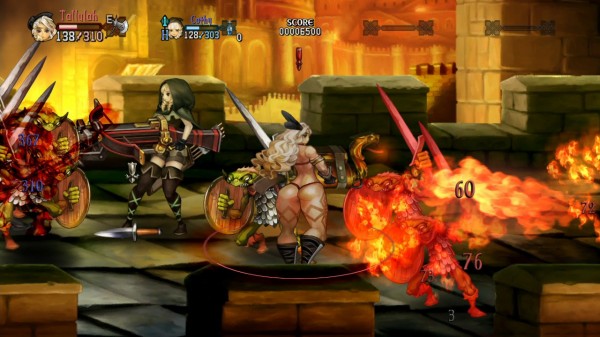
Cooperative play is no doubt a strong selling point for beat ‘em ups, and Dragon’s Crown includes four player coop play from the get go. In fact, up to twenty characters can be created on one save file. Whichever character is player one is the one that determines the progress of the game, but no matter what, you’ve always got space to create a new character with various friends that pop round to play with you.
Online is a little different. The online features of Dragon’s Crown do not unlock until you have played through all of the nine dungeons for the first time (roughly four or five hours). Once you’ve done that and gained the B routes, then you can set your game into “online” mode, which means people are free to join your game when you start a dungeon. You can also jump into a friend’s game or a random person’s, by simply clicking on the option in the stables or gates (the places in town that allow you to travel to the various locations). There is no voice chat or text communications, which might upset some people, but the game doesn’t require it. The tasks are easy to understand, and if you want to point something out, then you can use the in-game pointer to do so. The gameplay is one that requires zero communication between players – everyone knows what to do in Dragon’s Crown. Online is very active and I never once had an empty room, thanks to the Japanese game already out overseas.
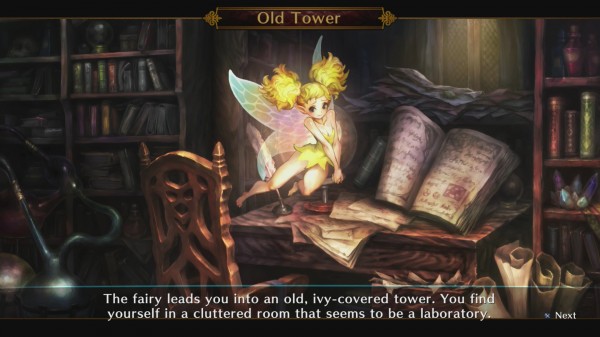
It must be stated that even though Dragon’s Crown is on both the PS3 and the Vita, the only feature you will gain from owning both of these games is the cross-save functionality. There is no other interaction between the two games. This means no cooperative or local play between the two. It’s a shame that none of this is included. Cross buy isn’t even available too, so you’re going to have to pay double the money if you want to take some Dragon’s Crown on the go. I personally feel the PS3 version is the better choice, as you can couch coop play from the get go, while the Vita version requires other Vita users and ad-hoc to set up cooperative play. Also, it requires you to have the first nine dungeons (just like how the online play works) to do local cooperative on the Vita, which is not a requirement in the PS3 version. As for performance, the Vita version runs decently, but does occasionally drop frames from time to time.
I suppose I can’t really finish a review without mentioning the art of Dragon’s Crown. There have been some outspoken opinions on what is portrayed in the game, but I find that everything is so eccentric, so exaggerated and so over the top that none of the characters, well apart from the Elf, seem anything close to “normal.” One thing I do feel though is that George Kamitani’s art is absolutely gorgeous, even more so seeing it at 1080p on a big screen TV. Vanillaware and Kamitani have a knack for creating wonderful looking worlds, and Dragon’s Crown is no doubt their most stunning work to date. The art and animation are clearly done from love, with painstaking detail enriched in the environments, the bosses and of course the characters that litter the world. This painted style is so unique in video games that it deserves all the attention from the player, and you shouldn’t feel bad if you just want to stare at it for a while. Unlockable art is available by doing side quests. These are also beautiful paintings and would make for some fine posters on my wall or on my computer screen.

Looking back on Dragon’s Crown, I really don’t have a major fault with the game. The story is weak, but the genre is one that can live without needing a strong narrative. Dragon’s Crown is also longer than most beat ‘em ups on a first completion, so even if you don’t want to play it multiple times, it’s still a good chunk of hours to get through. I see myself throwing Dragon’s Crown into my PS3 just to have a hour or two with my characters. If you wanted to playthrough the game with all six characters and beat all three difficulties with them all, then you’re easily looking at over 100 hours of gameplay. While it isn’t all new content the next time round, playing with online gamers and having quality combat and level design makes the grind go away.
Dragon’s Crown is Vanillaware’s best title to date. Not only that, but the company should be extremely proud of what they have accomplished. As the industry shows, it’s not easy to create a beat ‘em up that is mechanically solid, plays well and has depth to keep you coming back, but the studio has done just that. I’ve never really been able to fully 100 percent commit to recommending a beat-em-up without some explanation about a game’s shortcoming. But for Dragon’s Crown, it’s so superb that I can instantly throw an approval out that. Dragon’s Crown rearranges my top three beat-em-ups that once included Streets of Rage 2, Guardian Heroes and Teenage Mutant Ninja Turtles IV: Turtles in Time, classic titles that now have a new brother in beat ’em up history.
